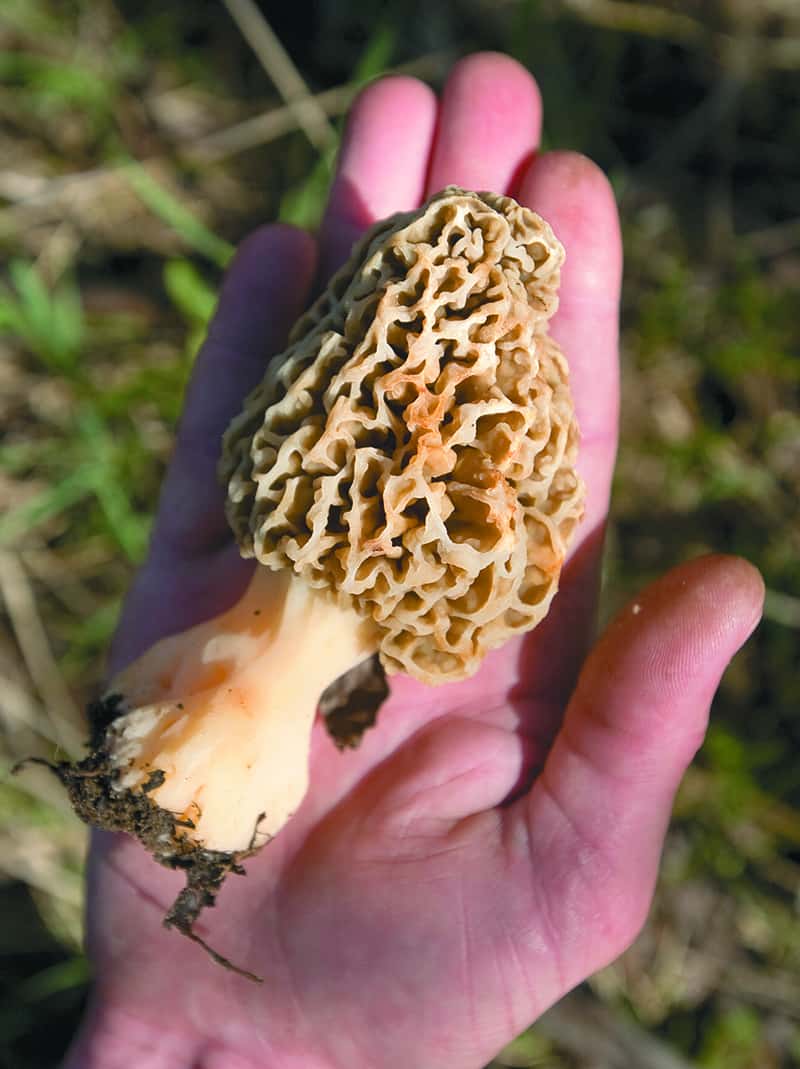Read The
Current Issue
The Magic of Mushrooms
Why and how you should hunt for wild mushrooms
By Julie Fustanio Kling

Photo by Price Chambers
In Jackson Hole, mushroom foraging is a serious hobby. A fly fisherman is more likely to share his honey hole with you than a mushroom forager is to share hers. Morels, chanterelles, and porcini grow around northwestern Wyoming and adjacent lands in Idaho. We’re not going to reveal any secret spots, but generally morel hunters look for silty, sandy soil near south-facing cottonwoods. Areas that burned in a forest fire the prior year can be especially mushroom-rich. “The idea is if there is a bad burn, the spores send a message that this is the last chance to grow before the soil gets depleted,” explains Amy Bryan, who started foraging in 2004 and now goes out every spring—morel season is hard to peg but usually lasts a couple of weeks in the late spring—with her husband, Bomber Bryan, and their three daughters. “The exhilaration is akin to an Easter egg hunt,” Amy says. “You’ve got to get your mushroom eyes on.” Bomber says, “Then you go hogwild. We can never get enough, and we love sharing them with friends.”
Of course the Bryans won’t give up the specifics of their stashes, but they will share that they hunt early season along the river banks of the South Fork of the Snake River in Idaho. The family then gradually works its way back east to Jackson Hole and then north to Grand Teton National Park (GTNP). (But they never forage in GTNP; it’s illegal to harvest mushrooms there.) The Bridger-Teton National Forest (BTNF), which manages much of the wild land in and around Jackson Hole, allows people to take up to 1 gallon of mushrooms a day.
In Jackson, chanterelles and porcini are rarer than morels, and their season is different. Annie Fenn, of Jacksonholefoodie.com, says to look for them at higher altitudes after August and September rains. Chanterelles often hide near huckleberry bushes, a favorite food source of bears, so bring your bear spray.

WHAT TO DO WITH YOUR MUSHROOMS?
Whether you cook your mushrooms right away, can, dehydrate, or freeze them, the first thing to do is clean them. A toothbrush is a good instrument to get any grit out of the cap. To air dry: Lay mushrooms on a tarp outside in the sun for a day, but make sure to bring them inside before the dew falls. Putting them in the oven at a low temperature works well, too. Once dehydrated, store them in Mason jars. To freeze, fill a Ziploc with mushrooms and then pour broth, preferably a homemade vegetable or chicken stock, over them. Freeze this whole bag. Dried mushrooms are much smaller than fresh ones. The Bryans often harvest about 80 pounds, and by the time they’ve dried them, everything fits into five, 2-gallon Ziplocs.
Don’t want to wait? Freshly picked mushrooms taste great in omelets, pizza, and with salmon and steak. Experts recommend seasoning them with thyme or sprinkling them with crispy pancetta. Some chefs dust mushrooms with flour before sautéing them.
MUSHROOMS ON THE MENU
Glorietta Trattoria serves grilled wild mushrooms done in a cast-iron skillet with rosemary, shallots, and lemon. (gloriettajackson.com, 307/733-3888, 242 Glenwood St.) Bin22’s pulled Mozzerella with wild mushrooms sautéed with white onions and sprinkled with bacon is one of its most popular dishes. (200 W. Broadway, 307/739-9463, bin22jacksonhole.com)
At the Snake River Grill, chef Jeff Drew serves New York strip steak with Parmesan risotto, roasted chanterelles, spinach, and pan jus. (84 E. Broadway, 307/733-0557, snakerivergrill.com)
FAKE OUT
There are false chanterelles and morels, some of which can be poisonous. False morels are usually not hinged at the cap and are filled with fibrous tissue (real morels are hollow). Chanterelles are often confused with jack-o’-lanterns, which are more orange than yellow, grow in clusters and sometimes share stems, and have a knife-like gill underneath. (Chanterelles have a fork-like gill that runs down the stem.) Porcini poinsonous lookalikes are hard to distinguish from the real thing; if you’re just starting out foraging, have an expert verify your haul.
PROPER MUSHROOM HUNTIN ETIQUETTE INCLUDES:
• Putting the mushrooms you find into mesh bags (so that their spores can fall out the bottom);
• don’t ask others where to forage;
• and leave the bottom of the stem of the mushrooms you harvest.
NOT ALL MUSHROOMS ARE CREATED EQUAL
While all mushrooms are earthy, each has a distinct flavor. Morels are meaty with a honeycomb texture that absorbs whatever you cook them in. Chanterelles are woodsy with a hint of apricot. Porcini are nutty and rich with umami, a savory flavor found in glutamates. JH





